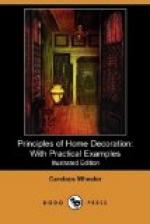If the walls are covered with a light wall-paper which carries a floral design, it is a safe rule to make the ceiling of the same colour but a lighter shade of the background of the paper, but it is not by any means good art to carry a flower design over the ceiling. One sometimes sees instances of this in the bedrooms of fairly good houses, and the effect is naturally that of bringing the ceiling apparently almost to one’s head, or at all events, of producing a very unrestful effect.
A wood ceiling in natural colour is always a good feature in a room of defined or serious purpose, like a hall, dining-room, or library, because in such rooms the colour of the side walls is apt to be strong enough to balance it. Indeed a wooden ceiling has always the merit of being secure in its place, and even where the walls are light can be painted so as to be in harmony with them. Plaster as a ceiling for bedrooms is open to the objection of a possibility of its detaching itself from the lath, especially in old houses, and in these it is well to have them strengthened with flat mouldings of wood put on in regular squares, or even in some geometrical design, and painted with the ceiling. This gives security as well as a certain elaborateness of effect not without its value.
For the ordinary, or comparatively inexpensive home, we need not consider the ceiling an object for serious study, because it is so constantly out of the line of sight, and because its natural colourless condition is no bar to the general colour-effect.
In large rooms this condition is changed, for in a long perspective the ceiling comes into sight and consciousness. There would be a sense of barrenness and poverty in a long stretch of plain surface or unbroken colour over a vista of decorated wall, and accordingly the ceilings of large and important rooms are generally broken by plaster mouldings or architectural ornament.
In rooms of this kind, whether in public or private buildings, decorative painting has its proper and appropriate place. A painted ceiling, no matter how beautiful, is quite superfluous and indeed absolutely lost in a room where size prevents its being brought into the field of the eye by the lowering of long perspective lines, but when the size of the room gives unusual length of ceiling, no effect of decoration is so valuable and precious. Colour and gilding upon a ceiling, when well sustained by fine composition or treatment, is undoubtedly the highest and best achievement of the decorative painter’s art.
Such a ceiling in a large and stately drawing-room, where the walls are hung with silk which gives broken indications of graceful design in play of light upon the texture, is one of the most successful of both modern as well as antique methods of decoration. It has come down in direct succession of practice to the school of French decoration of to-day, and has been adopted into American fashion in its full




